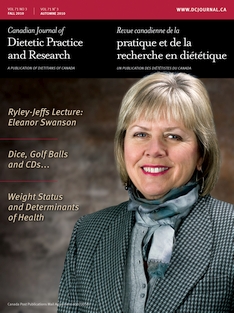Abstract
Purpose: Differences in body image and dieting concerns were assessed in preadolescent boys and girls across the body mass index (BMI) spectrum. The hypothesis was that girls would express more concern with body size, report more dieting, and receive more advice than boys.
Methods: In this cross-sectional descriptive study, ageappropriate figure drawings, the Children's Eating Attitudes Test (ChEAT), the Restraint Scale, and the Body Esteem Scale were administered to participants in the Study of Asthma, Genes and Environment, Manitoba. Responses were compared between genders and correlated with BMI percentiles.
Results: A total of 565 10- and 11-year-old children (321 boys) completed questionnaires. Overall, 39% of participants wanted to be thinner, and no significant gender differences based on weight were found. However, the use of figure drawings indicated that girls desired greater changes in body size (p=0.006). Girls had higher Restraint Scale scores (p=0.003), but no statistically significant differences were found in self-reported dieting, ChEAT, or Body Esteem Scale scores. Approximately 25% of children reported receiving frequent weight-related advice. Girls did not report this more often than did boys. Children in the lowest BMI percentile desired the greatest change in body shape and had the highest Restraint Scale scores.
Conclusions: Key gender differences underline the importance of understanding children's attitudes toward body image, weight, and dieting.
Résumé
Objectif: Les différences sur le plan des inquiétudes relatives à l'image corporelle et aux régimes ont été examinées dans un échantillon de préadolescentes et de préadolescents couvrant la gamme des indices de masse corporelle (IMC). L'hypothèse était que les filles exprimeraient plus d'inquiétudes relatives à leur corps et rapporteraient avoir fait plus de régimes et avoir reçu plus de conseils que les garçons.
Méthodes: Dans cette étude transversale descriptive, les outils suivants ont été utilisés avec les participants de la Study of Asthma, Genes and Environment du Manitoba, à savoir des dessins de silhouettes appropriés à l’âge, la version pour enfants du test sur les attitudes envers l'alimentation (ChEAT), une échelle de restriction et une échelle d'estime corporelle. Les réponses ont été comparées entre les sexes, puis corrélées avec les percentiles d'IMC.
Résultats: Un total de 565 enfants de 10 et 11 ans (321 garçons) ont rempli les questionnaires. Globalement, 39 % des participants désiraient être plus minces, et aucune différence significative fondée sur le poids n'a été observée selon le sexe. Cependant, l'utilisation des dessins a permis de déterminer que les filles désiraient davantage de changements sur le plan corporel (p = 0,006). Les filles ont obtenu de plus hauts scores sur l’échelle de restriction (p = 0,003), mais aucune différence statistiquement significative n'a été observée quant aux régimes effectués ainsi que sur le plan du ChEAT ou de l’échelle d'estime corporelle. Approximativement 25 % des enfants ont rapporté recevoir fréquemment des conseils relatifs au poids. Les filles n'ont pas rapporté ce phénomène plus souvent que les garçons. Les enfants présentant les plus faibles IMC étaient ceux qui désiraient le plus de changements sur le plan corporel; ce sont aussi eux qui ont obtenu les plus hauts scores sur l’échelle de restriction.
Conclusions: Les différences clés sur le plan du sexe soulignent l'importance de comprendre les attitudes des enfants envers leur image corporelle, leur poids et les régimes.



